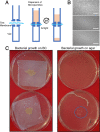On the function of biosynthesized cellulose as barrier against bacterial colonization of VAD drivelines
- PMID: 34548588
- PMCID: PMC8455583
- DOI: 10.1038/s41598-021-98220-4
On the function of biosynthesized cellulose as barrier against bacterial colonization of VAD drivelines
Abstract
Bacterial colonization of drivelines represents a major adverse event in the implantation of left ventricular assist devices (L-VADs) for the treatment of congestive heart failure. From the external driveline interface and through the skin breach, pathogens can ascend to the pump pocket, endangering the device function and the patient's life. Surface Micro-Engineered Biosynthesized cellulose (BC) is an implantable biomaterial, which minimizes fibrotic tissue deposition and promotes healthy tissue regeneration. The topographic arrangement of cellulose fibers and the typical material porosity support its potential protective function against bacterial permeation; however, this application has not been tested in clinically relevant animal models. Here, a goat model was adopted to evaluate the barrier function of BC membranes. The external silicone mantle of commercial L-VAD drivelines was implanted percutaneously with an intervening layer of BC to separate them from the surrounding soft tissue. End-point evaluation at 6 and 12 weeks of two separate animal groups revealed the local bacterial colonization at the different interfaces in comparison with unprotected driveline mantle controls. The results demonstrate that the BC membranes established an effective barrier against the bacterial colonization of the outer driveline interface. The containment of pathogen infiltration, in combination with the known anti-fibrotic effect of BC, may promote a more efficient immune clearance upon driveline implantation and support the efficacy of local antibiotic treatments, therefore mitigating the risk connected to their percutaneous deployment.
© 2021. The Author(s).
Conflict of interest statement
S.B., F.R. and A.F. are working for Hylomorph AG. No further conflict of interest relevant to this article has been reported.
Figures




References
-
- Ponikowski, P. et al. 2016 ESC Guidelines for the diagnosis and treatment of acute and chronic heart failure: The Task Force for the diagnosis and treatment of acute and chronic heart failure of the European Society of Cardiology (ESC). Developed with the special contribution of the Heart Failure Association (HFA) of the ESC. Eur. J. Heart Fail.18, 891–975. 10.1002/ejhf.592 (2016). - PubMed
Publication types
MeSH terms
Substances
LinkOut - more resources
Full Text Sources

